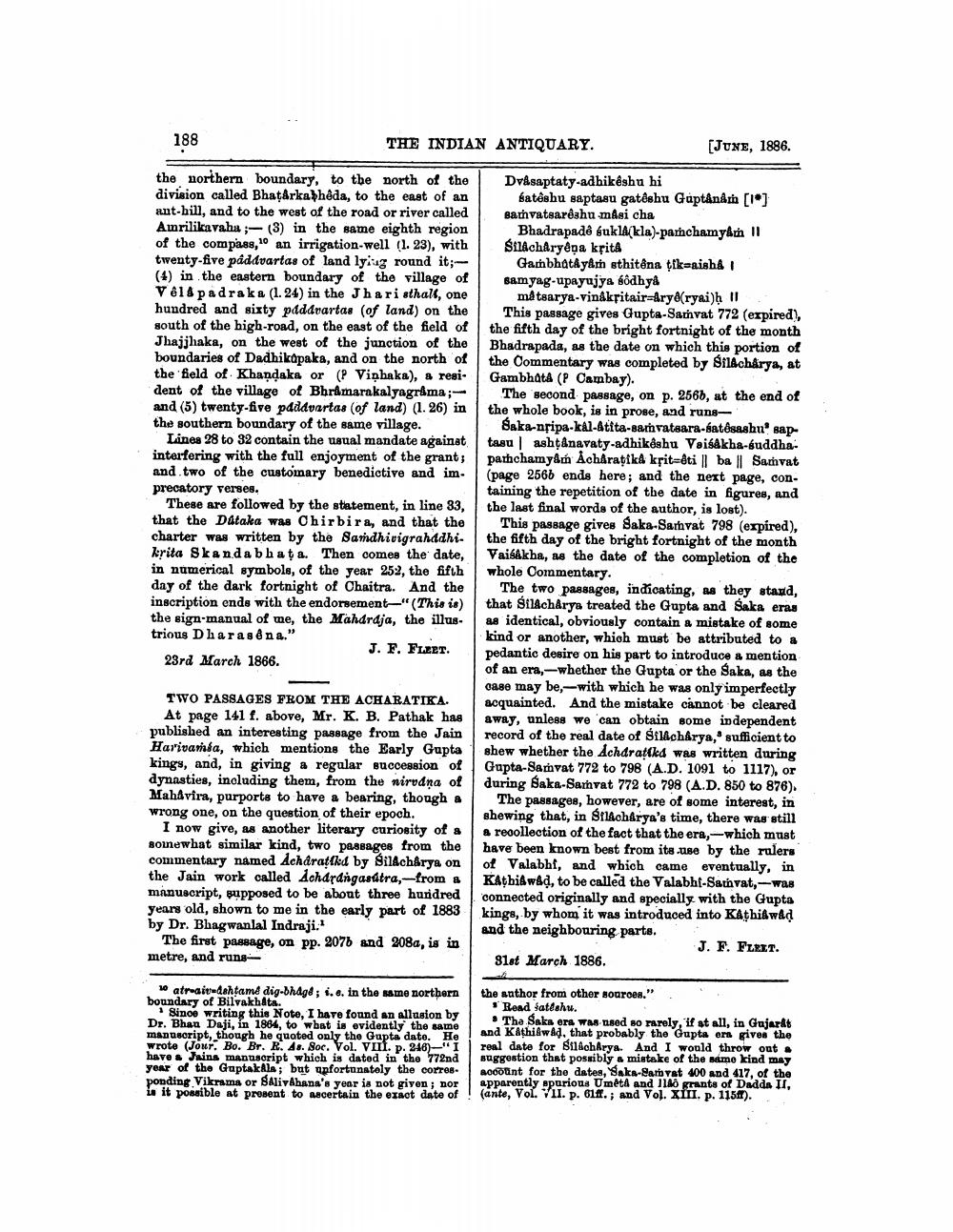________________
188
THE INDIAN ANTIQUARY.
[JUNE, 1886.
the northern boundary, to the north of the division called Bhatárkaphêda, to the east of an ant-hill, and to the west of the road or river called Amrilikavaha ; (3) in the same eighth region of the compass, an irrigation-well (1. 23), with twenty-five påddvartas of land ly 2 round it; (4) in the eastern boundary of the village of V 618 padraka (1. 24) in the Jhari athall, one hundred and sixty paddvartas (of land) on the south of the high-road, on the east of the field of Jhajjhaka, on the west of the junction of the boundaries of Dadhikapaka, and on the north of the field of Khandaka or (P Viņhaka), & resi. dent of the village of Bhramarakalyagrama;- and (5) twenty-five pdidvartas (of land) (1.26) in the southern boundary of the same village.
Lines 28 to 32 contain the usual mandate against interfering with the full enjoyment of the grant ; and two of the customary benedictive and im. precatory Terses.
These are followed by the statement, in line 83, that the Dataka was Ohirbira, and that the charter was written by the Sandhivigrahadhi. krita Skanda bha ta. Then comes the date, in numerical symbols, of the year 252, the fifth day of the dark fortnight of Chaitra. And the inscription ends with the endorsement—"(This is) the sign manual of me, the Mahardja, the illustrious Dhara sê na."
J. F. FLET. 23rd March 1866.
Dv&saptaty-adhikeshu hi
batêshu saptasu gatêshu Gaptânám [lo] Bathvateardshu masi cha
Bhadrapada bukl/kla)-pamchamyan 11 SilAchAryêpa krita
Gambhatåyån sthitêna tikanishi samyag-upayujya kôdhya
matsarya-vinákritairdrye(rynih 11 This passage gives Gupta-Samvat 772 (expired), the fifth day of the bright fortnight of the month Bhadrapada, as the date on which this portion of the Commentary was completed by SilAcharya, at Gambhata (P Cambay).
The second passage, on p. 2560, at the end of the whole book, is in prose, and runs
Saka-npipa-kalatita-samvatsara-batēsashu saptasu ashtänavaty-adhikeshu Vaisakha-buddhaparfchamy&m Achåraţika kpit-êtil ba | Samvat (page 2566 ends here; and the next page, containing the repetition of the date in figures, and the last final words of the author, is lost).
This passage gives Saka-Samvat 798 (expired), the fifth day of the bright fortnight of the month Vaisakha, as the date of the completion of the whole Commentary.
The two passages, indicating, as they stand, that Silacharya treated the Gupta and Saka eras as identical, obviously contain a mistake of some kind or another, which must be attributed to a pedantic desire on his part to introduce a mention of an era, -whether the Gupta or the Saka, as the case may be, with which he was only imperfectly acquainted. And the mistake cannot be cleared away, unless we can obtain some independent record of the real date of Silacharya,sufficient to shew whether the Achdratkd was written during Gupta-Samvat 772 to 798 (A.D. 1091 to 1117), or during Saka-Sarvat 772 to 798 (A.D. 850 to 876).
The passages, however, are of some interest, in shewing that, in Stacharya's time, there was still
recollection of the fact that the era, which must have been known best from its use by the rulers of Valabht, and which came eventually, in Kathiawad, to be called the Valabhi-Samvat, -was connected originally and specially with the Gupta kings, by whom it was introduced into Kathiawad and the neighbouring parts.
J. F. Flat. 31st March 1886.
TWO PASSAGES FROM THE ACHARATIKA.
At page 141 f. above, Mr. K. B. Pathak has published an interesting passage from the Jain Harivanía, which mentions the Early Gupta kings, and, in giving a regular succession of dynasties, including them, from the nirudna of Mahavira, purports to have a bearing, though a wrong one, on the question of their epoch.
I now give, as another literary curiosity of a somewhat similar kind, two passages from the commentary named Acharaţkd by SilAcharya on the Jain work called Acharangasútra,- from a manuscript, supposed to be about three hundred years old, shown to me in the early part of 1883 by Dr. Bhagwanlal Indraji.
The first passage, on pp. 2076 and 208a, is in metre, and runs
10 atrait-dahtama dig-bhagd; 1. e, in the same northern the anthor from other souroen." boundary of Bilvakhta.
Read fatéshu. Since writing this Note, I have found an allusion by Dr. Bhau Daji, in 1864, to what is evidently the same
The Saks era was need 80 rarely, if at all, in Gujarat manuscript, though he quoted only the Gupta dato. He
| and K AthiAwad, that probably the Gupta ers gives the wrote (JOMT. Bo. Br. R. As. Soc. Vol. VIII. p. 246)—"I real date for SilachArya. And I would throw out. have a Jains manuscript which is dated in the 772nd suggestion that possibly a mistake of the same kind may Year of the Guptakals; but upfortunately the corros. Bobolint for the dates, Saks-Earn Yat 400 and 417, of the ponding Vikrams or Aliv Abans'a year is not given nor apparently spurious UmétA and 11A grants of Didda II. is it possible at prosent to sacertain the exact date of ! (ante, Vol. VII. p. 617., and Vol. X . p. 11511).




